VVAM Newsletter 76 – 1999
FRIENDS OF THE AIRBORNE MUSEUM
Editors:Drs. R.P.G.A. Voskuil, C. van Roekel, G.H. Maassen jr.
Newsletter No. 76, October 1999
Translated by Cathrien and Peter Clark
Representative in Great Britain: Mr. E.E. Shaw, 298 Totnes Road Paignton – Devon TQ4 7HD Tel. 0803-553616

The Lender of the Pilgrimage, Major General A.J. Deane- Drummond (left) talking to Major Tony Hibbert near the Operation Pegasus I crossing point.
(Photo: C. van Roekel)
From the editors
The 55th commemoration of the Battle of Arnhem is
already one and a half months in the past. They were hectic days in which many things happened that are worthy of mention. This naturally means that a major part of this enlarged Newsletter is given over to photos and reports of the events.
Besides these you will of course find the latest on the Society of Friends and the Airborne Museum. It is the future intention to introduce a number of items about the museum into the Newsletter under fixed
headings. Board members of the Airborne Museum Foundation and the museum’s full-time employees will be responsible for these items, and the headings you can expect to come across are: ‘The Museum’ and ‘Museum activities’ by W. Boersma; ‘From the archives and library’ by A. Groeneweg; ‘The Museum on the internet’ and ‘The Museum shop’ by B. de Reus; ‘From the collection’ and ‘Recent acquisitions’ by R. Boekhorst.
Once again, many books on the Battle of Arnhem have been recently published. These will be reviewed in this and the next edition.
Theme afternoon, 20 November 1999
The annual theme afternoon will be held in the Concert Hall, Rozensteeg 1, Oosterbeek on Saturday 20 November next.
The afternoon will concentrate entirely on the Royal Netherlands Army’s Recovery and Identification Service. This service’s responsibilities in the Netherlands include the exhumation and identification of the remains of allied servicemen who died during the war.
The programme is as follows:
13.00 – 13.30 hours: Reception of the members.
13.30 -14.45 hours: Lecture on the general
activities of the Recovery and Identification Service.
14.45-15.30 hours: BREAK.
15.30 -16.30 hours: Lecture on the service’s work
in Renkum Municipality and surroundings.
Approx. 17.00 hours: End of the theme afternoon.
Normandy reunion
A reunion of participants in the spring excursion to Normandy will be held in the Airborne Museum on the evening of Friday 26 November 1999. The meeting room will be open from 19.30 hours. Don’t forget to bring your photographs and videos!
10th Battalion’s Colours donated to the Airborne Museum
During a special ceremony held on Saturday 18 September, the two standards of the 10th Battalion The Parachute Regiment were handed over to the Airborne Museum. Prior to the ceremony a service took place in the Old Church in Lower Oosterbeek during which the Reverend R.F. Bowers, chaplain to the 10th Battalion in 1944, talked of the bond that exists between the battalion and our municipality.

With military ceremony the standards of the 10th Battalion The Parachute Regiment are handed over to the Airborne Museum.
(Photo: Berry de Reus)
After the service the Colour Guard marched with the standards to Hartenstein.
The 10th British Parachute Battalion was raised in Kabrit, Egypt, in 1942 and first saw action in Italy. On 18 September 1944 some 600 men of the battalion under the command of Lt Col K.B.I. Smyth landed on Ginkel Heath. The battalion formed part of the 4th Parachute Brigade, whose job it was to occupy the area to the north of Arnhem. During their advance they encountered strong German resistance near ‘De Leeren Doedel’ restaurant, forcing them to alter the line of advance towards Oosterbeek. On arrival in the village they were given orders to occupy positions in a number of houses in Annastraat and Utrechtseweg, east of the Schoonoord Hotel. This sector of the perimeter was defended against German attacks from the east and north-east until the end of the battle. In the night of 25/26 September 1944 the remnants of the battalion crossed back over the Rhine along with the rest of the division. Only 35 men of the 10th Battalion reached allied lines.
After the Second World War the 10th Battalion became a territorial unit (Volunteer Battalion), comparable to the Dutch ‘National Reserve’.
The use of standards by army units goes back a long way in time, and in the 17th century they were already being referred to in the British army as ’the Colours’. In those days the banners did indeed vary in colour as a means of recognition of the unit(s) concerned. During the 18th century the number of standards per unit was reduced to two. These are the Queen’s Colour, which consists of a British flag bearing the names of the battles in which the unit concerned has been involved (the Battle Honours), and the Regiment’s Colour, which is in the colour of the regiment and bears the regimental badge or emblem.
When the Colours need replacing or if a unit is disbanded, it is usual for the old Colours to be hung in the church to which the unit feels attached.
In 1952 the 10th (Volunteer) Battalion The Parachute Regiment received its Colours. They were replaced in 1983, the old being placed in the Regiment s church, St Lawrence Jewry, near the Guildhall in London. The reorganisation of the British Army in 1999 led to the 10th Parachute Battalion being disbanded. To illustrate its connection with Oosterbeek the battalion wished to have its Colours placed in the Old Church in Lower Oosterbeek, however it is not customary for military standards to be hung in churches in the Netherlands. The battalion therefore decided to present the Colours to the Airborne Museum.
The handing-over of the standards took place on the front lawn of the museum with full military pomp. General Sir Rupert Smith, KCB, DSO, OBE, QGM, deputy commander-in-chief of NATO, attended the ceremony as representative of the British Army. In his address he emphasised the fact that it was 55 years to the day that the 10th Parachute Battalion dropped on Ginkel Heath, and that the battalion, after a week of heavy fighting, was more or less annihilated only a few hundred metres from where the standards were now being handed over. That the standards will be kept in Oosterbeek is unique, because it is virtually unheard of for Colours to be held in countries outside of the British Isles or the Comm o n wea 1 th.
The Colours will be housed in a large showcase that has been built in the hall of the Airborne Museum where they will be on show to the visiting public. (W. Boersma)

just before the start of the memorial service at the Airborne Cemetery, the clergymen who will lead the service make their way to the pulpit with, in front, the Reverend R.F. Bowers.
(Photo: Berry de Reus)
4th edition of the Roll of Honour
The presentation of the new ‘Roll of Honour, Battle of Arnhem 1944’ took place during the AGM of the Arnhem Veterans Club on the evening of Thursday 16 September. More than a year of preparation had preceded the event, a year in which Geert Maassen and Chris van Roekel, together with the compiler Ian Hey, worked intensively on the production of this 4th edition. Much new information had been prowded by various sources over the past years and all this has now been included in this new issue The first impression appeared in 1986, followed a year later by the second. In 1993 it was decided to publish a revised edition, and now we have a fourth, completely re-vamped issue. The ‘Roll of Honour’ contains the names and all other information on men of the 1st British Airborne Division, the 1st Polish Independent Parachute Brigade Group, the Royal Air Force and other military units that were involved in the Battle of Arnhem in the south-west ‘Veluwezoom’ and at Driel, and who lost their lives during or as a result of the fighting in September 1944.
This edition of the ‘Roll of Honour’ is published by the Society of Friends of the Airborne Museum and 500 copies have been printed. The reference work is of A4 format, contains 174 pages and is illustrated with photographs and maps. It is available from the Airborne Museum and in Oosterbeek bookshops, price f 40,-.
REME bench unveiled
On Saturday afternoon 18 September 1999, a bench to the memory of the men of the 1st Airborne Workshop Royal Electrical and Mechanical Engineers (REME) who took part in the Battle of Arnhem in September 1944 was unveiled in the Hartenstein park. The bench was made by men of the present-day REME. Burgomaster Verlinden accepted the bench on behalf of the Municipality of Renkum, and it has been placed close to the spot where the REME held positions in 1944. Mr Don Jacobs, who himself served in the REME and now works part- time for the museum, instigated the setting up of the bench.

Burgomaster Verlinden reads the inscription on the backrest of the recently unveiled REME bench at the rear of the Airborne Museum.
(Photo: Berry de Reus)
Purchase of unusual bulldozer
Most people are probably unaware that the 1st British Airborne Division look a small American bulldozer to Arnhem in September 1944. This vehicle, the AMM/Clark CAI ‘Clarkair’, was transported by Horsa glider. The bulldozer was intended for use by 261 Field Park Company Royal Engineers for the clearance of landing zones and the eventual construction of an airstrip. The way the Battle of Arnhem developed rendered this impossible. The machine was driven from the

Mr Mervyn Potter poses beside the Clarkair bulldozer purchased for the Airborne Museum by the Society of Friends. In September 1944 Mr Potter served with 261 Field Park Company Royal Engineers, which took a similar bulldozer to Arnhem.
(Photo: Berry de Reus)
landing zone to Oosterbeek, where it was parked in the grounds of the then Sonnenberg Castle.
Earlier this year a collector of military vehicles in Zele (Belgium), a Mr E. Janssens, offered a Clarkair bulldozer for sale. After consulting with the Foundation Board, the Friends’ Society management decided to buy this unique vehicle for the museum, and on Monday 13 September delivery took place. For the time being the little bulldozer will go into storage in Oosterbeek and restoration work will begin in the spring of next year. This work will be led by one of our volunteers, Jaap Jansen, former Adjutant in the Technical Service. Society members who are willing to help with this project are asked to get in touch with the museum, tel. 026-3337710. The restoration is expected to be completed in time for the Airborne commemoration in September 2000. It is also the intention that one of the future ministories will feature the Clarkair.
Commemorative envelope, 1999
A new commemorative envelope was released on 17 September last. This latest issue by the Airborne Museum is the fourth in a series with ‘The monuments of the Battle of Arnhem’ as subject. This new envelope depicts the Airborne Monument in Arnhem, that consists of part of a broken column from the Arnhem Palace of Justice, destroyed in 1944. Arnhem architect J. van Biesen came up with the idea of using this piece of column and, on the advice of Arnhem sculptor Gijs Jacobs, it was placed beside the ramp of the Rhine bridge as a temporary monument. In 1953 a definitive monument was erected on the Kerkplein near Eusebiuskerk, but the ’temporary’ Airborne monument was retained. In 1954 the column was moved to the Damcircuit at the end of the northern approach to the John Frost bridge. Every September a wreath is laid here to commemorate the Battle of Arnhem.
500 numbered copies of the commemorative envelope have been produced. They bear two 80 cent commemorative postage stamps from 1998 (‘100 jaar inhuldiging Koningin Wilhelmina’ – 100th anniversary of the coronation of Queen Wilhelmina) and have been franked ’17 September 1999′ with the Oosterbeek post office branch stamp. The envelopes are on sale at the Airborne Museum for 7 guilders.

The standards are lowered during the commemoration at the bridge in Arnhem.
(Photo: Berry de Reus)
Backgrounds to an excavated ‘find’
One of the types of radio transmitter used by the 1st British Airborne Division during the Battle of Arnhem was the ‘Wireless set no.22’. The 22 set was developed in Britain in 1941 by the Pye Ltd. company as a replacement for the ageing No. 11 (High Power) set. Normally the set was transported by vehicle, although it could also be used as a portable radio. However, this required a three men team. A modification was introduced halfway through 1944 enabling the set to be tuned using crystals. The ‘WS no. 62’ was a later development of the ‘WS no. 22 MK 1’. Approximately 55,000 no. 22 wireless sets were produced during the Second World War.
The 1st British Airborne Division used the 22 set for such things as brigade to battalion and brigade to HQ communications. The set was also used for communication with the Royal Artillery. Telephonic range was 15 km and 30 km for telegraphy.
Early in the nineties a 22 set that had been used during the battle was unearthed in Oosterbeek at the northern corner of Kneppelhoutweg and Hoofdlaan. It was found between a brick-built pillar and an oak tree. Prior to this, veteran Robert Whelan had told Mrs Beelaerts van Blokland from Oosterbeek that he had buried his radio set there, but Captain John Lee, Troop Commander of ‘A’ Troop, 1st Airlanding Light Regiment, Royal Artillery, had said some years before that it was he who had buried the set there. However, according to John Lee it was near a brick pillar on the south side of the road. When the radio was found he wrote to the late Ed van Dam in 1994, saying: ‘Of course I am fascinated by the story of the 22 set. There was just one in that area and it came from my jeep. I was using a trench to the south of the crossing. I cannot remember if there was one on the north side too. I know for certain that I buried the set at the bottom of the trench on the south side of the road. The name Whelan does ring a bell but I can t bring him to mind. My Gun Position Officer, Lieutenant Tom Barron, thinks that he was one of our people. I am intrigued to know where the information came from that Robert Whelan buried the set and how it came to be on the other side of the road. As far as I can see it will remain a mystery’.
(W. Boersma)
The restoration of the excavated WS 22 radio set
Shortly after the radio set mentioned in the above article was found it came into the hands of the Airborne Museum. First of all it had to be dried out in a heated area, after which restoration work could begin. The front was partially treated with an anti¬rust agent because corrosion had begun to take its toll. Contact corrosion had been caused by the aluminium and copper components and some of the aluminium had been eaten away. After treatment with the anti-rust agent it was once again possible to get some movement in most of the set’s control knobs. The year ‘1942’ was clearly legible on the meter. When removed from its casing the radio set appeared to be complete. The traces of rust and corrosion were removed. The set’s valves were covered with a layer of dirt about 1 cm thick. This was scraped off very carefully and the valves could then be removed from their housings. After a clean-up they were put back in place. The wiring was still mainly intact.
The casing was made completely rust-free but some of it had rotted away. There was also some other damage, probably caused when the unit was dug up. From above one can now see the set’s ‘internals’, while the original colour can still be seen on the outside. All the webbing carrying straps have rotted away.
 ine restored zz radio set that teas unearthed at the corner of Kneppelhoutweg and Hoofdlaan almost 50 years after the Battle of Arnhem. J
ine restored zz radio set that teas unearthed at the corner of Kneppelhoutweg and Hoofdlaan almost 50 years after the Battle of Arnhem. J
(Photo: R. Boekhorst)
Although the Airborne Museum possesses an example of all the types of radio set used in the Battle of Arnhem, this is the only original set about which the history is known.
(Roland Boekhorst, preservationist, Airborne Museum)
 19 September 1999. In a long column of more than 100 old military vehicles the veterans are driven around the villages of the Municipality ofRenkum (Photo: Berry de Reus)
19 September 1999. In a long column of more than 100 old military vehicles the veterans are driven around the villages of the Municipality ofRenkum (Photo: Berry de Reus)
From the archives and library
The subject of the first article under this heading is the smallest piece of archive material in the museum. It is a pencil-written order from Brigadier P.H.W. Hicks, commander of the 1st Airlanding Brigade that landed around Reyerscamp on 17 and 18 September. The brigade comprised 1st Battalion The Border Regiment, 2nd Battalion The South Staffordshire Regiment and 7th Battalion The King’s Own Scottish Borderers.
The 1st Border battalion took up positions on the western side of what would eventually become the Perimeter. In doing so they were the only unit to follow the original operational order. A, C, D and B companies lay from north to south respectively, from Sonnenberglaan to the then gasworks in the Lower Village. HQ company and Battalion HQ were in Van Lennepweg and D company HQ was located in the long farmhouse halfway along Van Borsselenweg. On 25 September, Corporal Alan Fisher from D company was detailed to collect orders from Battalion HQ. Knowing nothing of the plans for the withdrawal of the division across the Rhine, he was given a small note by Brigadier Hicks. On the way back to his company he came under mortar fire which prevented him reaching his company commander. However, he did come across some men from his own company and took them along with him. Corporal Fisher managed to cross the Rhine but the rest of D company, unaware of the withdrawal, were taken prisoner. Later, Corporal Fisher donated the note to the Airborne Museum. It is written on poor quality paper and the text is faint, too faint to be copied. It reads: ‘Coy: Monument 21.00, P. Hicks, 25-9’. The monument in question was that to Mrs ‘U.M. Kneppelhout, geboren Van Braam, en wijlen haren onvergetelijken echtgenoot. Het dankbare Oosterbeek’- U.M. Kneppelhout, nee Van Braam, and her late, unforgettable husband. A grateful Oosterbeek) and is to be found on the west side of Hoofdlaan on Hemelse Berg. With this note Hicks intended D company to assemble by the monument at 9 ‘o clock in the evening of 25 September and then cross back over the Rhine.
The original note can be seen in the museum by appointment with A. Groeneweg.
(A. Groeneweg)
Airborne Museum website
Http/ / www.airbornemuseum.com is the internet address of the Airborne Museum’s website. Messrs J. van Slooten, Peter Klaassen and Berry de Reus have been working on the preparation of the site for the past few months. Initially it will contain information aimed at promoting the museum. One will be able to surf to a simple presentation that will provide general information such as opening times, admission charges, etc. The site will also contain a photo page showing a number of pictures of the museum and dioramas. By clicking on the so-called ’thumbnails’ it will be possible to enlarge a photo and increase its resolution. In addition there is a year overview of activities in and involving the museum. The future intention is to extend the site to include reports on special items and to show what is available for sale in the museum shop. Purchases could then eventually be ordered via the internet. The presentation will be further enhanced by links to other sites. If you would like more information or have any queries you can make use of the museum’s e-mail address: hartenstein@wxs.nl.
(B. de Reus)
‘Red Berets and Red Crosses’
A beautifully produced book about the medical services of the 1st British Airborne Division during World War II was published on September 3 this year under the above title. It is written by one of our English members, Niall Cherry (40), who has been researching the subject for many years.
Captain Peter H. Starling (Retd), Curator of the Army Medical Services Museum in Aidershot, had this to say about this new standard work:
‘Many books have been written about the Airborne Forces during World War 2 but very few give justice to or tell the story of the men of the Airborne Medical Services. Here, in a single volume, is the complete story of part of the airborne medical services, that of the 1st Airborne Division, from its beginnings in the early days of the war to the disbandment of 1st Airborne Division in November 1945.
From the early days of airborne forces there was a need for medical personnel, not only to accompany the fighting troops but to become heavily involved in the evolution of airborne forces and the trials of aircraft and equipment and their effect on the human body. Colonel A. Austin Eagger OBE was the first senior medical officer to be posted to the division and was shortly after joined by Captain T.R.B. Courtney as his assistant. These two officers were the founding fathers of the airborne medical services. The author takes us through these early days, fraught with the problems of transporting troops by air, the airsickness that 80% of glider-borne troops suffered from, the lack of lightweight medical equipment, the search for a means of transporting stretchers by wheeled vehicle once on the ground, to name but a few. Over seventy veterans of the divisional medical services have been interviewed and their reminiscences are interspersed with details of these early days.
It was not long before members of the RAMC were in action, accompanying the cross-channel raid on the radar site at Brimeval. Subsequent operations in North Africa, Sicily and Italy are dealt with in great detail and readers can read of the personal experiences of members of the RAMC and ADC and the hardships they suffered whilst trying to bring comfort to their wounded comrades.
The real strength of this book is in its account of the part played by the medical services during the battle for Arnhem & Oosterbeek. This has never before been told in such great detail, with members of the medical services own accounts interspersed with details from official records and reports. The greater part of the battle took place in and around the divisional hospital area with the dressing stations falling in and out of enemy hands constantly and coming under shell and small arms fire with great regularity. When the decision to withdraw the remnants of the division was reached, the medical services were instructed to remain behind with the wounded and endure the subsequent captivity which followed, and here we read of their accounts as POWs. The final chapter of the book takes us into disbandment via a short journey to Norway and the German surrender.
The book is complemented by over 100 illustrations (many published for the first time), maps and tables and will be recognised as the reference work on this subject for many years to come. The author, himself a former member of the RAMC, is to be congratulated for achieving this’.
Captain Peter Starling thus.
‘Red Berets and Red Crosses’ is published by Robert Sigmond in Renkum and printed by Veenman Drukkers in Ede. (ISBN : 890 804718 1 X). The book is available in the Netherlands via the Airborne Museum and from various local bookshops, price 49.50 guilders. In England it can be bought at the Army Medical Services Museum in Aidershot and at the Border Regiment Museum in Carlisle Castle, price 17 pounds 95p.
 Niall Cherry, author of the book ‘Red Berets and Red Crosses’, photographed in front of‘De Tafelberg’ in Oosterbeek. He is holding the parachute helmet of Corporal Ken Holdsworth, 181 Airlanding Field Ambulance, who worked there in 1944.
Niall Cherry, author of the book ‘Red Berets and Red Crosses’, photographed in front of‘De Tafelberg’ in Oosterbeek. He is holding the parachute helmet of Corporal Ken Holdsworth, 181 Airlanding Field Ambulance, who worked there in 1944.
(Photo: R. Voskuil)
Through the lens of De Booys
Last year an exhibition of the work of the well- known Arnhem photographer P.J. de Booys was held in the Arnhem Municipal Archives in celebration of thelOOth anniversary of his birth. Now, due partly to the enormous interest that the exhibition aroused, an extremely interesting book has been published entitled ‘Door de lens van De Booys. Een Arnhem reportage 1944-1954’ (Through the lens of De Booys. An Arnhem report 1944-1954). It was compiled by Drs. P.R.A. van Iddekinge.
Photographer De Booys achieved particular fame for the cold-blooded way in which he secretly took scores of photos of the plundering of the town in the autumn of 1944, when Arnhem had been forcibly evacuated by the Germans. Had the Germans been aware that their activities were being recorded on film, De Booys would almost certainly have paid with his life. These fascinating photographs of the plundering and the evacuation give us a penetrating
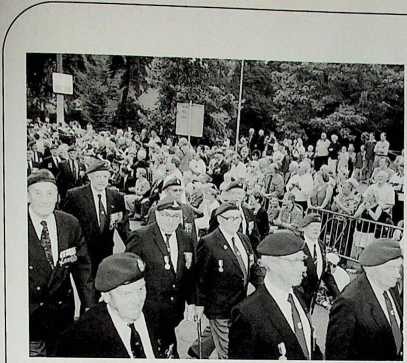
The veterans march from the Airborne Museum to the Town Hall to the accompaniment of loud cheers from the local inhabitants during the Farewell Parade on Sunday afternoon, 19 September. (Photo: Berry de Reus)
image of the situation in Arnhem in the autumn of 1944. When the liberation begins in April 1945 De Booys is in Velp, where he records the entry of the allied troops in a series of photographs. After the liberation he returns to Arnhem. He photographs the enormous destruction in the town and surroundings and shows how the populace attempts to re-establish a normal existence. In the years following the war he records on film the rebuilding of the town as well as all manner of festivities.
From the thousands of photos De Booys took, the compiler of the book has selected 212. The result is an absorbing image of one of the most turbulent periods in Arnhem’s history.
‘Door de lens van De Booys’ comprises 160 pages and is published by Matrijs of Utrecht. It costs 39.95 guilders.
‘Capture at Arnhem’
The book ‘Capture at Arnhem, a Diary of Disaster and Survival’ in the series Military Memoirs/World War II has recently been published in England. It was written by Captain H.R. Roberts.
As a Lieutenant during the Battle of Arnhem he was second-in-command of the Advanced Workshop Detachment of the 1st Airborne Workshop, Royal Electrical and Mechanical Engineers.
Directly after arriving on landing zone ‘Z’ to the south of the Arnhem-Ede railway line on 18 September 1944, Harry Roberts was hit by German machine gun fire. Because of this he took no further part in the battle and the actions of the REME. In his book Roberts describes his personal experiences, first as a casualty during the battle and then as a prisoner- of-war in Germany.
As a casualty he was taken via Wolfheze to the Vreewijk Hotel in Oosterbeek, and after the battle to Stalag XIB in Germany by way of Apeldoorn. At first he concealed is rank, but in spite of this was later taken to a camp for officers, Oflag IX A/Z near
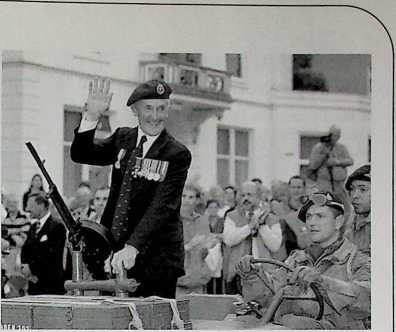 Standing on a jeep. Brigadier Mike Dauncey leads the Farewell Parade.
Standing on a jeep. Brigadier Mike Dauncey leads the Farewell Parade.
(Photo: Berry de Reus)
Rotenburg. His book is based mainly on the diary he kept up to 18 April 1945, the day he was liberated. The story gives a good impression of the lot of more than 6,000 British prisoners-of-war after the Battle of Arnhem. Roberts writes about day-to-day life in the hospitals and the camps. Food is a major subject and, among other things, he describes how he managed to supplement his rations through contact with the civilian population. Roberts ends his book with the story of the 16-day forced march through Germany, his liberation by the Americans and his return home. ‘Capture at Arnhem’ shows another side of the Battle of Arnhem. During the ‘Liberators behind Barbed Wire’ exhibition in the Airborne Museum in 1998, it became clear that there are far more unpublished stories by and about prisoners-of-war than had ever been suspected.
Captain Roberts died in 1992 and his wife has succeeded in having his manuscript published seven years after his death.
‘Capture at Arnhem’ is in paperback and is published by the Windrush Press, Moreton-in- Marsh, Gloucestershire (ISBN 1 900624 27 3). The book consists of 148 pages and is illustrated with photographs and a map. It is available at the Airborne Museum for 35 Guilders.
(W. Boersma)
Video film
Production of a video film about the commemorations on Ginkel Heath and at Driel is under way. The film mainly concerns the veterans who made the parachute drop this year and also incorporates footage from TROS TV and TV Gelderland. The wreath laying at Driel is shown at the end of the video.
Anyone interested in this professionally produced video should contact C.C. van den Bosch, Utrechtseweg 173, 6812 AC, Arnhem. If there is sufficient interest it is expected that the film will be ready at the beginning of next year and cost approx. 25 guilders.
(C. van den Bosch)
Message from your UK representative
A kindly reminder that your subscriptions are due in January 2000. Any outstanding 1999 subscriptions will also be welcome!
(Ted Shaw, UK representative)
Unique commemorative medal
The Airborne Walk, Pegasus Walk and Capitulation Liberation Walk organisation committees have presented a so-called ‘Liberation walk passport’. This gives one the opportunity of obtaining a ‘Wageningen Liberation Town 2000’ commemorative medal. To achieve this one has to ‘do’ each of the above walks once during the period 4 September 1999 to 12 May 2001 inclusive. Successful completion of each walk will be marked with a stamp in the passport, and those eventually managing to collect all three stamps will be considered for the above- mentioned medal.
(B. de Reus)
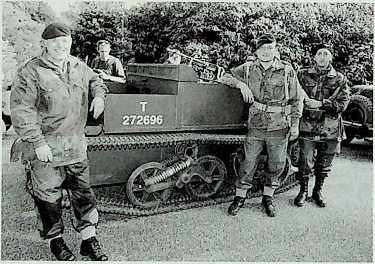
A Bren-gun carrier was among the old military vehicles displayed to the public by the ‘Airborne Battle Wheels Oosterbeek’ society.
(Photo: Berry de Reus)
‘Point Blank, Open Sights’
A booklet entitled ‘Point Blank, Open Sights’, telling the story of the 1st Airlanding Anti-Tank Battery, Royal Artillery, was published on 5 June this year. Its author John C. Howe served with this unit during the war.
The book begins with the fighting in France, the escape via Dunkirk and the unit’s rebuilding.in England. Actions in North Africa and Sicily follow the 1st Airlanding Anti-Tank Battery’s attachment to the 1st Airborne Division. It is in fact the first unit to have its guns transported to the battlefield by glider. After returning to England the 1st Anti-Tank Battery is attached to the 1st Parachute Brigade. In September 1944 they take part in the Battle of Arnhem, where they suffer heavy casualties. The last operation in which they are involved is the liberation of Norway.
‘Point Blank, Open Sights’ comprises 118 pages, is illustrated with photos and maps and contains a list of names and a ‘Roll of Honour’. It is published by Hough Publishing, 16 Merrick House, Reigate Road, Reigate RH2 0QH, Surrey. In the Netherlands it costs 35 guilders and can be ordered from Eugene Wijnhoud, Bernhardlaan 41-1, 6824 LE, Arnhem, telephone 026-3513100.
(Eugene Wijnhoud)
Final part of ‘Blik Omhoog’ published
The fourth book in the series ‘Blik Omhoog’ about the wartime history of Wolfheze and the South Vein we and written by our member Cor Janse appeared on 17 September this year. Besides a comprehensive register of 3,100 people and more than 900 placenames, this Supplement (‘S’) contains all manner of additions and explanations relating to the previously published volumes. One of the subjects dealt with is the role of the Dutch SS during the Battle of Arnhem.
Book ‘S’ contains 144 pages and costs 25 guilders. It is available from the Airborne Museum and from the Oosterbeek bookshops.
Decoration for Gerrit Pijpers
On 19 September, Gerrit Pijpers, board member of the Airborne Museum Foundation, was awarded the Order of Oranje Nassau with Swords. Gerrit Pijpers, a major in the Netherlands Royal Air Force, has been involved since 1975 in the organisation of countless activities within the cadre of the Battle of Arnhem commemorations. Since 1994 he has organised the memorial service at the Airborne Cemetery in his capacity as Dutch representative of the Airborne Forces Security Fund. The Friends’ Society board warmly congratulates Gerrit on this well-deserved decoration.
Philip Reinders honorary member of the ‘Arnhem 1944 Veteran’s Club’
At the AGM of the Arnhem 1944 Veteran’s Club held on 16 September, Society member Philip Reinders from Rlieden was nominated honorary member of the Club. He received this award for the huge amount of historical research he has carried out on subjects relating to the Battle of Arnhem.

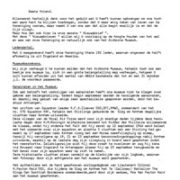
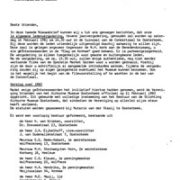
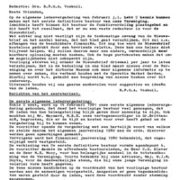
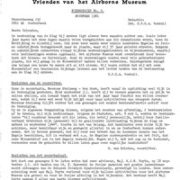
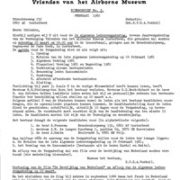
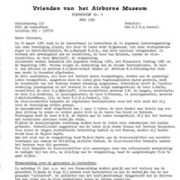
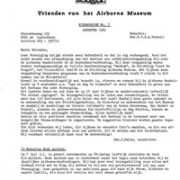
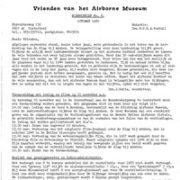
Plaats een Reactie
Vraag of reactie?Laat hier uw reactie achter.